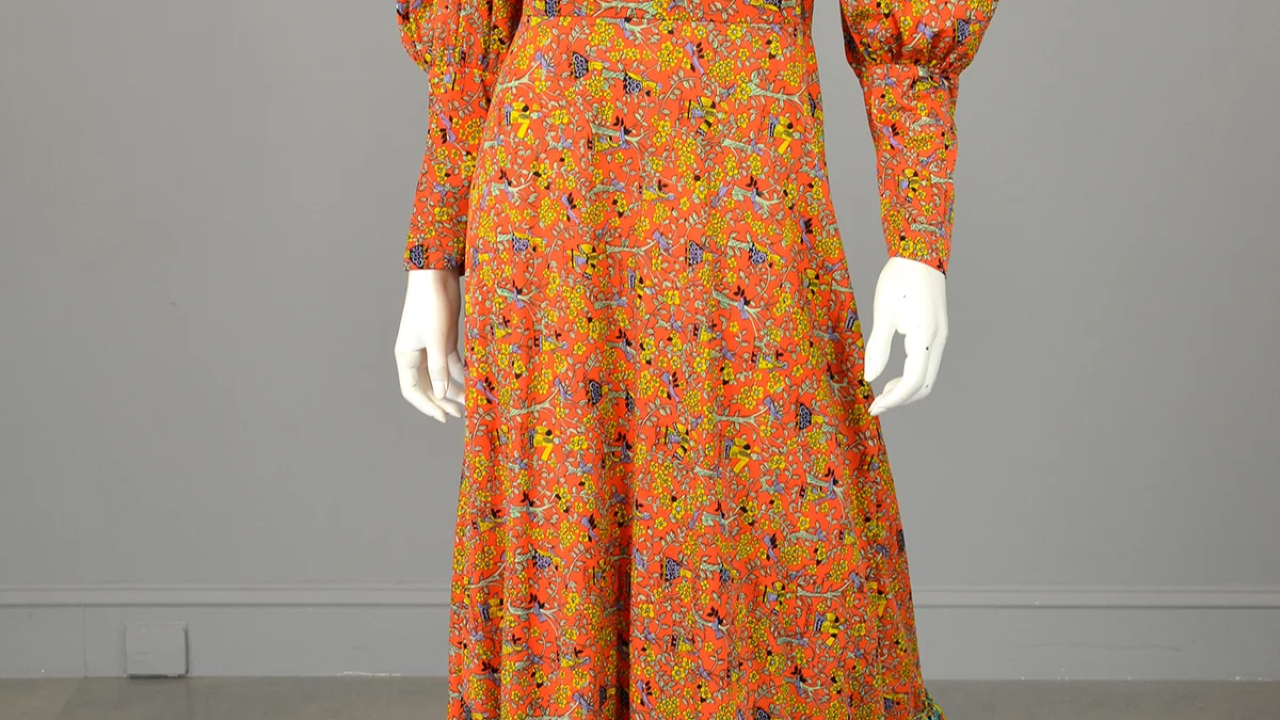AllVintageStyles
Vintage fashion encyclopedia
Prairie Dress


A 1970s prairie dress is a long-sleeved, high-necked dress with ruffles and lace trim that romanticized American frontier fashion, representing the decade's nostalgia for rural life and rejection of modern synthetic styles in favor of romantic, handcrafted aesthetics.
Quick Facts
- Era: 1970s (peak popularity 1974-1978)
- Origin: United States (romanticized American frontier fashion)
- Garment Type: Long-sleeved dress with romantic prairie-inspired details
- Key Identifiers: High neckline, long sleeves, ruffles, lace trim, floor or ankle length
- Typical Resale Price: $40-$180 (authentic vintage pieces)
- Best For: Romantic vintage styling, folk festival wear, and bohemian fashion enthusiasts
History & Evolution
The prairie dress emerged in the mid-1970s as part of the decade's romanticization of American frontier life, influenced by television shows like "Little House on the Prairie" and the broader back-to-the-land movement that idealized rural simplicity over urban sophistication. The style represented rejection of synthetic modern fashion in favor of natural materials and handcrafted details.
The dress became mainstream fashion worn by young women embracing the era's romantic aesthetic and its emphasis on feminine innocence, natural beauty, and connection to American heritage. The high necklines, long sleeves, and modest styling appealed to those seeking alternatives to the decade's more revealing fashions while maintaining bohemian sensibilities.
Quality vintage prairie dresses featured natural cotton or calico construction, hand-finished lace trim, and authentic folk-inspired details that reflected genuine craftsmanship rather than mass-produced imitations. The style represented the 1970s idealization of simpler times and traditional feminine roles. Today, authentic prairie dresses are prized by collectors for their romantic details and representation of the decade's folk revival movement.
Authentication Tips
Authentic 1970s Features:
- Natural cotton or calico fabric construction with period-appropriate prints
- Hand-finished or quality machine lace trim and ruffle details
- High necklines with button closures or tie details typical of the era
- Long sleeves with gathered or elasticized cuffs in frontier styling
- Vintage sizing that tends to run smaller with longer torso measurements
Common Reproductions/Modern Pieces:
- Synthetic materials or cotton blends not available in 1970s folk fashion
- Machine-made trim or plastic lace that lacks vintage quality and authenticity
- Contemporary fitted cuts that contradict authentic prairie dress proportions
- Modern comfort features or elastic that weren't part of original romantic styling
- Poor quality construction that compromises the handcrafted folk aesthetic
Styling & Use Cases
- Best for romantic enthusiasts: Pair with boots, layered jewelry, and natural makeup for authentic 1970s folk revival styling
- Ideal for bohemian occasions: Style with earth-tone accessories and flowing hair for modern vintage-inspired romantic looks
- Perfect for festival wear: Combine with natural accessories and comfortable shoes for folk music festivals and outdoor events
Modern styling tips:
- Belt at natural waist to create contemporary proportions while maintaining the dress's romantic folk aesthetic
- Layer with denim jackets or cardigans for updated casual styling that honors the vintage romantic appeal
- Pair with ankle boots or contemporary sandals for comfortable modern wear with vintage romantic character
FAQ
Q: How can I tell if a prairie dress is authentic 1970s vintage?
A: Look for natural cotton construction, hand-finished lace trim, high necklines with period closures, long sleeves with gathered cuffs, and vintage sizing. Authentic pieces show construction typical of 1970s folk fashion and romantic movement.
Q: What's the typical price range for vintage 1970s prairie dresses?
A: Authentic vintage prairie dresses range from $40-$180 depending on lace quality, condition, and construction details. Pieces with exceptional hand-finished details or designer labels command higher prices among collectors.
Q: How should I care for a vintage 1970s prairie dress?
A: Hand wash gently in cold water to preserve cotton fabric and lace trim, or machine wash on delicate cycle. Air dry to prevent shrinkage and protect the romantic construction details.
Q: What makes 1970s prairie dresses valuable to collectors?
A: Their representation of 1970s folk revival and back-to-the-land movements, romantic construction with hand-finished details, association with American frontier nostalgia and cultural television influence, and embodiment of the decade's rejection of synthetic fashion in favor of natural, handcrafted romantic aesthetics.
📷: Vintage Virtuosa
